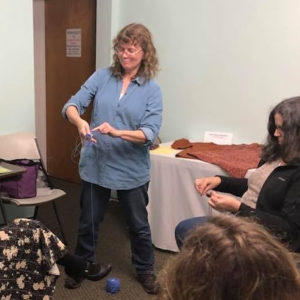Teaching Tips: Developing Your Mental Library
One of the key difference between teaching adults and teaching children is that adults come to class with a rich collection of prior experiences. So when you teach knitting classes with adult learners, you have the opportunity to help the students draw out that prior experience to learn the new skills you are teaching.
Some of your students’ prior experiences will be with the fiber arts. They may have crocheted, or embroidered, or sewed, and each of these crafts has related experiences. For instance, crocheters usually tension the yarn with their left hand, so in beginning knitting classes, I will show crocheters how to knit Continental style rather than English style as it is usually easier for them. Weaving in ends may make more sense if it can be related to embroidery.
Other times, prior experience is related to other fields that can be applied to knitting. For instance, students who have experience writing computer code may find it helpful for me to show how reading a pattern is similar to reading code.
 I also find that some students find more benefit to visual cues in diagrams, others find it easier to repeat a rhyme or catchphrase, and still others will learn best from mirroring my hands in motion. These preferences are often based on prior experience or work related skills. Because of this, I try to have at least three different ways to explain any skill in that I teach in a knitting class. Some of these I’ve developed by listening to how one student will explain a task to another student. Others have been gathered from watching other teachers and from reading a variety of books. A few have been created on the fly when no other explanation seems to work for a student and I’ve had to invent a new way to explain a task.
I also find that some students find more benefit to visual cues in diagrams, others find it easier to repeat a rhyme or catchphrase, and still others will learn best from mirroring my hands in motion. These preferences are often based on prior experience or work related skills. Because of this, I try to have at least three different ways to explain any skill in that I teach in a knitting class. Some of these I’ve developed by listening to how one student will explain a task to another student. Others have been gathered from watching other teachers and from reading a variety of books. A few have been created on the fly when no other explanation seems to work for a student and I’ve had to invent a new way to explain a task.
To help me know what might work best for a given class, I always take some time for introductions and find out what related skills students may already have. If I have a large class and don’t have time for individual introductions, I use a quick verbal survey and hand raising to get an idea of student experiences and prior knowledge.
Having a mental library of different ways to explain a skill will help all your students to be successful. Note that your mental library may include tricks and techniques that would not be useful at all to you as a learner, but they may be useful to one of your students. Becoming a successful teacher is in part developing the ability to teach those who learn in different ways.